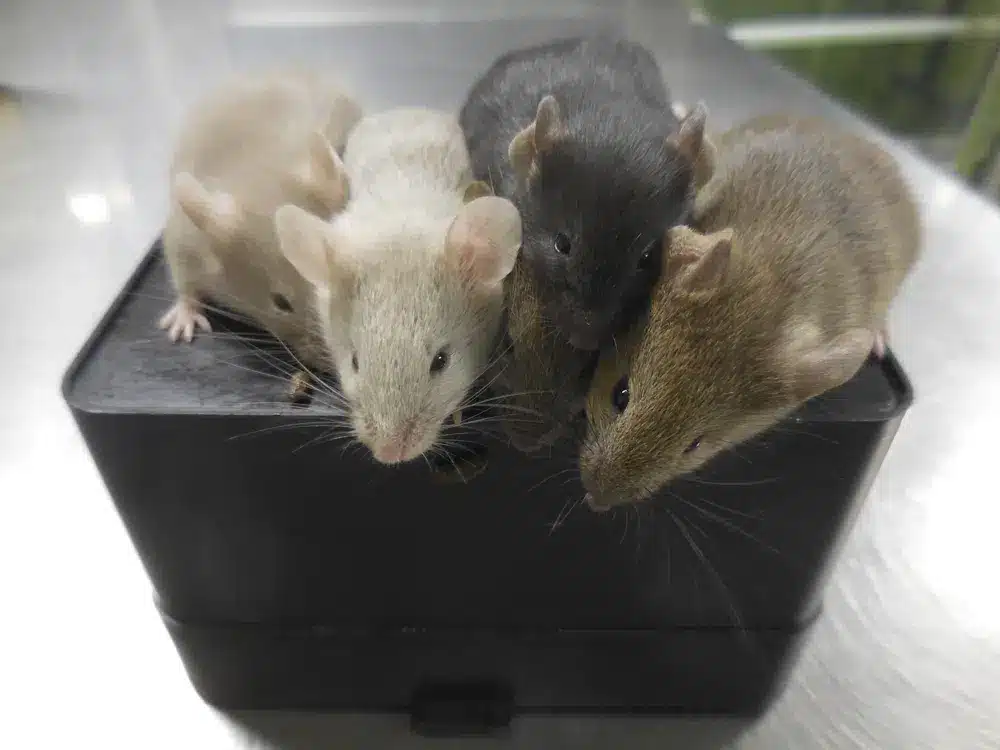Science
Scientists Create Mice With Cells From 2 Males For 1st Time

Scientists have produced baby mice from two guys for the first time.
Although specialists caution that only a few mice embryos matured into live mouse pups, and no one knows whether it will work for humans, this raises the remote potential of employing the same approach on people.
But even so, “It’s a pretty creative method,” said Diana Laird, a stem cell and reproductive person at the University of California, who was not involved in the study. It’s a crucial phase in both reproductive biology and stem cell research.
Researchers revealed their work in a paper published in the journal Nature on Wednesday.
First, they created “induced pluripotent stem cells” from skin cells removed from the tails of male mice. These cells can differentiate into a variety of different cell or tissue types. They then developed functioning egg cells by converting male mouse stem cells into female cells by expanding them and administering medication. The embryos were then placed into female mice after being fertilized. 7 of the 630 embryos, or around 1%, developed into living mouse pups.
Last week, scientists at the Third International Conference on Human Genome Editing heard from research leader Katsuhiko Hayashi of Kyushu University and Osaka University in Japan that the pups appeared to develop properly and could become parents on their own in a typical way.
Laird and her colleague Jonathan Bayerl wrote a commentary that was published alongside the Nature publication in which they stated that the work “opens up new pathways in reproductive biology and mice fertility research” for both people and animals. In the future, it is feasible to procreate endangered mammals from a single male.
Unclear why so few embryos implanted into surrogate mice survived.
They said it “could even give a pattern for enabling more people to produce biological children while avoiding the ethical and legal concerns of donor eggs,” such as male same-sex couples.
However, they issued multiple warnings. Which is the most notable? The method could be more effective. They claimed it was unclear why so few embryos implanted into surrogate mice survived; there may be technical or biological reasons for this. However, they emphasized that it is still too early to determine whether the approach would even function with human stem cells.
Before employing stem cells to create eggs, Laird added that researchers must consider the mutations and mistakes that might be made in a culture dish.
The most recent study explores novel approaches to in vitro mouse embryogenesis. This summer, researchers in Israel and California developed “synthetic” mouse embryos from stem cells that lacked a mother’s ovum or egg. Up to 8 12 days after conception, those mice embryos had the same characteristics as typical mouse embryos, including one that resembled a beating heart. The achievement, according to scientists, could one day serve as a model for producing artificial human embryos for future research.
SOURCE – (AP)
Science
Canadian Researchers Look to Plants for Bacterial Infections

Canadian researchers are exploring novel techniques with plants to address major difficulties caused by bacterial infections, such as using antibacterial plants to control bacteria in poultry meat.
Antibiotics have been routinely used in poultry farming to prevent and treat bacterial infections. Antibiotic overuse has resulted in the rise of antibiotic-resistant microorganisms, endangering both animal and human health.
This has pushed scientists to investigate alternative methods of controlling bacterial infections in chickens, Agrinews Group reports.
Researchers in Canada are investigating the antibacterial properties of native plant extracts. Rumex and Potentilla are two distinct plants that have proven potential.
These plants are being studied for their effectiveness in battling bacterial infections such as Avian Pathogenic E. coli (APEC), a common cause of chicken sickness.
Rumex and Potentilla fight bacterial infections.
Dr. Sophie Kernéis-Golsteyn, a microbiologist at Lethbridge Polytechnic in Alberta, leads a 2.5-year Egg Farmers of Canada program.
Since 2016, her team has been testing native plants for antibacterial properties, collecting 150 samples. Rumex and Potentilla extracts are highly effective at protecting chickens from bacterial diseases.
These plants’ antibacterial properties are attributed to their ability to increase beneficial microbiota and stimulate the production of digestive enzymes. These botanical extracts reduce inflammation, strengthen the immune system, and improve overall productivity in poultry.
The use of antimicrobial flora in avian husbandry has many benefits. First, it reduces reliance on antibiotics, lowering the danger of antibiotic resistance.
Furthermore, it improves chicken health and well-being by boosting their immune response and digestive function. Finally, it aligns with client preferences for organic and sustainable agriculture practices.
While the potential benefits are significant, there are some drawbacks to consider. The efficiency of plant extracts may vary based on factors such as extraction technique, dosage, and the bacterial strains involved.
Furthermore, more research is required to fully understand the long-term impacts of using these plants in poultry production. The study of antimicrobial plants for bacterial control in chickens is a promising field of research in Canada.
Researchers are looking for effective and sustainable alternatives to antibiotics. One strategy is to leverage the natural properties of plants such as Rumex and Potentilla. This strategy reduces antibiotic resistance and improves the overall health and productivity of chicken farms.
Related News:
Mexico Wants US To Finance 4 Wind Power Plants
Science
Australia Asks Residents to Catch Deadly Funnel Web Spider

As summer approaches in Australia, residents are warned to look out for the funnel web spider, one of the country’s deadliest species.
In addition to advising the public to avoid funnel-web spiders during mating season, the Australian Reptile Park in New South Wales has even asked people to capture live funnel-web spiders so they can “milk” their venom.
Native to eastern Australia, the funnel web spider can kill humans in as little as fifteen minutes if they do not receive medical treatment for its poisonous bite.
There have been thirteen fatalities attributable to this species, but none since the development of antivenom in 1981. The Australian Reptile Park is appealing to the public for assistance capturing and donating spiders, as the serum relies on milking live spiders.
Hunting for the funnel net spider in residential areas is common practice after a particularly wet and warm season. Look for spiders in cool, dark places like pools, garden residue, heaps of dirty clothing, and outside shoes.
Australian Reptile Park spider keeper Emma Teni recently blogged about how they rely on spider donations more than ever, especially now that breeding season has arrived and the temperature is perfect.
“Male funnel-web spiders have short lifespans, and with approximately 150 spiders required to make just one vial of antivenom, we need the public’s help to ensure we have enough venom to meet demand.”
“If you spot an egg sac while collecting a spider, it’s important to safely collect that as well,” said Teni. “It can provide a robust supply of healthy young spiders to aid in our antivenom production.”
The spiders won’t be able to climb plastic or glass, but Teni suggests capturing funnel webs in a wide-mouthed jar with a cover. Then, you can lead the spiders into the container using a long spoon or something similar.
After that, fill the jar with moist soil, screw on the top, and bring it to the designated drop-off spot.
“We depend on the public for spider donations, and we want to make sure everyone stays safe during the collection process, especially with conditions being so favourable this year,” said Teni.
Related News:
Trudeau Orders Facebook to Block Presser Video from Australia
Science
A Spacecraft Is On Its Way To A Harmless Asteroid Slammed By NASA In A Previous Save-The-Earth Test

CAPE CANAVERAL, Florida – A spacecraft launched Monday to probe the site of a cosmic accident.
The European Space Agency’s Hera spacecraft launched on a two-year trip to the little, harmless asteroid slammed by NASA two years ago as a practice run for the day when a murderous space rock threatens Earth. It’s the second phase of a planetary defense experiment that could one day save the globe.
SpaceX’s Falcon rocket vanished with Hera into the late morning clouds. An hour later, cheering erupted in the control center in Germany as the spacecraft split from the rocket’s upper stage and returned home. “It’s an amazing day,” the space agency’s director general, Josef Aschbacher, said later.
The 2022 crash of NASA’s Dart spacecraft reduced Dimorphos’ orbit around its larger companion, indicating that if a harmful rock was heading our way, it might be pushed off course with adequate warning.
nasa
A Spacecraft Is On Its Way To A Harmless Asteroid Slammed By NASA In A Previous Save-The-Earth Test
Scientists are eager to analyze the aftermath of the impact up close to determine how effective Dart was and what improvements may be required to protect Earth in the future.
“The more detail we can glean the better as it may be important for planning a future deflection mission should one be needed,” University of Maryland astronomer Derek Richardson stated before launch.
Researchers want to know if Dart (short for Double Asteroid Redirection Test) created a crater or changed the 500-foot (150-meter) asteroid more dramatically. It seemed to be a flying saucer before Dart’s blow and may now resemble a kidney bean, according to Richardson, who participated in the Dart mission and is assisting Hera.
Dart’s wallop sent rubble and boulders hurtling off Dimorphos, adding to the impact’s momentum. For months, the debris track extended thousands of miles (almost 10,000 kilometers) into space.
According to flight director Ignacio Tanco, some rocks and debris may still be hovering about the asteroid, posing a threat to Hera.
A Spacecraft Is On Its Way To A Harmless Asteroid Slammed By NASA In A Previous Save-The-Earth Test
“We don’t really know very well the environment in which we are going to operate,” Tanco informed me. “But that’s the whole point of the mission is to go there and find out.”
European authorities refer to the $400 million (363 million euros) effort as a “crash scene investigation.”
“Hera is going back to the crime scene and getting all the scientific and technical information,” said project manager Ian Carnelli.
Carrying a dozen science instruments, the compact car-sized Hera must swing past Mars in 2025 for a gravitational boost before landing at Dimorphos by the end of 2026. It’s a moonlet of Didymos, the Greek word for twin, a five-times larger asteroid that spins quickly. At that point, the asteroids will be 120 million miles (195 million kilometers) from Earth.
Hera will attempt to enter orbit around the rocky duo, progressively reducing flyby distances from 18 miles (30 kilometers) to a half-mile (1 kilometer). The spacecraft will examine the moonlet for at least six months to determine its mass, shape, composition, and orbit around Didymos.
Before the crash, Dimorphos circled its larger partner from three-quarters of a mile (1,189 meters) away. Scientists believe the orbit has become tighter and more oval-shaped, and that the moonlet may be tumbling.
Two shoebox-sized Cubesats will launch from Hera for even closer drone-like examinations, with one employing radar to peek beneath the moonlet’s boulder-strewn surface. Scientists believe Dimorphos was produced from particles shed by Didymos. The radar measurements should assist in determining whether Didymos is the small moon’s parent.
A Spacecraft Is On Its Way To A Harmless Asteroid Slammed By NASA In A Previous Save-The-Earth Test
After their survey, the CubeSats will attempt to land on the moonlet. If the moonlet tumbles, the situation will become more complicated. Hera may potentially conclude its mission with a perilous touchdown but on the bigger Didymos.
Asteroids, which are remnants of the solar system’s origin 4.6 billion years ago, circle the sun principally between Mars and Jupiter in what is known as the main asteroid belt, where millions of them live. When they fall from the belt and land in our area, they become near-Earth objects.
NASA now has around 36,000 near-Earth objects, the majority of which are asteroids, although there are also some comets. More than 2,400 of them are deemed potentially dangerous to the Earth.
SOURCE | AP
-
Politics4 weeks ago
Miller Expects 4.9 Million Foreigners to Leave Canada Voluntarily
-
News3 weeks ago
Nolinor Boeing 737 Crash Lands in Montreal
-
News3 weeks ago
“Shocking Video” Vancouver Police Shoot Armed Suspect 10 Times
-
Tech4 weeks ago
Increasing its Stake in OpenAI by $1.5 Billion is a Possibility for SoftBank.
-
Tech3 weeks ago
Canadian Media Firms Are Suing OpenAI in a Potential Billion-Dollar Dispute.
-
News4 weeks ago
Trudeau Called the Greatest Threat to NATO

























